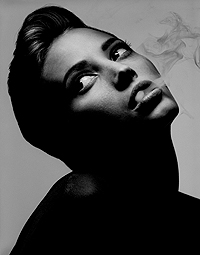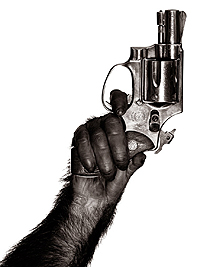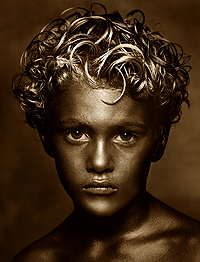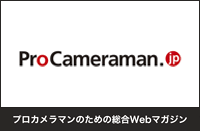Albert Watson氏の作品より

 
▲「Christy Turlington」 New York, 1990(クリックで拡大)
 
▲「Monkey with Gun」New York City, 1992(クリックで拡大)
 
▲「Golden Boy」New York, 1990(クリックで拡大)
 |
|
●Profile プロフィール
アルバート・ワトソンは過去40年間、自身のアートを創作し続けている。一方で彼は、世界で最も成功したファッションと広告写真家の1人と評価されている。長年にわたって氏の写真は各国Vogueの表紙を飾り、Rolling Stone、Time、Vibeなどの数えきれない出版物においてロックスター、ラッパー、俳優、セレブらの象徴的なポートレートがフィーチャーされた。
アルバートは多くの時間をパーソナルプロジェクトに注ぎ、3冊の本を出版している。「Cyclops」(1994年)、「Maroc」(1998年)、そして2007年にPhaidon社より出版された回顧本「Albert Watson」がある。2010年の秋には、Abrams/PQ Blackwellより2冊の新刊が出版された。1冊は「Strip Search」というラスベガスについての本、もう1冊はファッション写真を集めた「UFO: Unified Fashion Objectives」。そのほかにもアルバートの写真のカタログは、美術館やギャラリーの展示と共に出版されている。氏の作品は、永久収蔵品としてナショナル・ポートレート・ギャラリーやメトロポリタン美術館に納められている。
アルバートは、特徴的なルールとコンセプトに従ってビジュアルを展開する。輝き、切迫感、そして偉大ささえも感じさせる氏の写真は、世界の今日の画像の中でもひときわ輝きを放っている。特にフェティッシュな被写体やポートレートを撮る際の氏のライティングは、写真の中に熟慮された雰囲気を作り出している。
アルバート・ワトソンは、見るものの知覚を大いに豊かにさせるアーティストだ。氏の作品の幅広さは、それがラスベガスの女帝ポートレートであろうとツタンカーメン王の靴下の接写であろうと、その実力と高度な技術によってアルバート・ワトソンの写真だと特定できる。この完璧へのひたむきな献身さが、アルバートを世界でもっとも求められる写真家の1人にしている。
●Biography バイオグラフィー
PCJ:これまで、来日されたことはありますか?
Albert:はい。京都、大阪、そして私の大好きな東京に行ったことがあります。もし、私が日本語を話すことができたなら、東京に引っ越します。とても好きだからね。一生懸命日本語を学ぼうとしたのですが、とても難しかったです。
PCJ:あなたはとても有名ですから、多分問題なく過ごせるのでは?
Albert:私には通訳が必要だよ。。
PCJ:いつどこでお生まれになりましたか?
Albert:私はスコットランドのエディンバラで生まれました。私はスコットランド人です。
PCJ: あなたが写真を撮り始めたのは何歳の時からですか?
Albert: 本当に真剣に撮り始めたのは、私が最初にカメラを手に入れて、写真に興味を持ち始めた22歳のときです。4年間グラフィックデザインの勉強をして、大学院で3年間、映像の勉強をしましたが、私は写真に強く惹かれました。私の仕事は、映画などの映像とグラフィックデザイン、もしくはグラフィックと映像のコンビネーションに分類することができます。最終的にはスチル写真にいきましたが、私は多くの映像も手掛けています。
PCJ: 学生の頃、写真以外に興味を持っていたことはありましたか?
Albert: これらを行うことに莫大なエネルギーを費やしていました。私は1日中グラフィックを勉強し、さらに週1回写真を勉強していました。そして、映像の学校に通っていた時は、映像とTVを平日の昼間に勉強していたので、写真は夜と週末に勉強しました。他に何かをする時間はあまりなかったです。
PCJ: 映像、TVとグラフィックデザインを勉強したのですね。写真に関してのアカデミックなバックグラウンドはお持ちですか?
Albert: はい。先ほどにも言ったように、私は2年間、写真を勉強していました。週1回の授業でしたが、夜間は暗室での作業もできました。
PCJ: その時はスコットランドにいたのですか?
Albert: はい。私はスコットランドにあるセントアンドリューズ大学に行き、その後、映像とTVはロイヤルカレッジオブアートの大学院で学びました。
PCJ: あなたが小さい頃に影響を受けた映画や音楽、アーティストはいらっしゃいますか?
Albert: はい。私はたくさんの人の影響を受けました。何百人ものね。私は、日本からヨーロッパに至るまで、世界中の写真を見ていました。当時は、何人かの昔の日本人の写真家に興味があり、彼らにとても影響されました。野島康三はその中の1人です。確か彼は1964年に亡くなったと思います。1965年に出版された「Posthumous Works」を今見ています。荒木経惟も私は好きです。彼は面白いです。細江英公にも影響されました。日本で彼はとても有名ですね。私も細江氏と同じくロンドンの王立写真協会(Royal Photographic Society)で賞をいただいたのですが、その時に彼に一度会ったことがあります。
PCJ: いつ頃ですか?
Albert: そんなに前ではないです。彼はとても素晴らしい写真家でした。それにミニマリズムの写真家、杉本博司も私は好きです。他にも好きな日本の写真家がたくさんいます。私は1930年代のヨーロッパの写真家も好きです。ブラッサイ、アンドレ・ケルテスやロシアの写真家アレクサンドル・ロトチェンコが好きです。彼らは皆とても素晴らしい。アメリカ人では、ウィリアム・エグルストンが好きで、1930〜1940年代では、もちろん他の写真家も皆そうでしょうが、エドワード・ウェストンが好きです。
PCJ: 何故写真の道を選んだのですか?
Albert: これは答えるのは簡単です。一番最初にカメラを手にした時、私にとってはそれがとても自然で、扱いやすかったのです。とても心地よかった。これは、私がやるべきことだと思ったからです。
PCJ: グラフィックデザインより写真の方が好きなのですか?
Albert: 私はグラフィックデザインも好きです。これらはすべてつながっています。私は映画も大好きです。そして、もちろん他にもすべてのアートから影響を受けています。アンディ・ウォーホールでも、ピカソでも、印象派アーティストでも、すべてを見てください。すべてがとてつもなく素晴らしい。もし、世界をアーティストが動かしていたら、今よりも素敵な場所になるでしょう。
●Work 活動内容
PCJ: 現在、一番興味を持っている被写体やテーマはなんですか?
Albert: 私は今パリの展覧会のための作品を制作中です。ヌードとフルーツを撮っています。ヌードもフルーツもすべて水の中で撮っています。水を撮っているとも言えるでしょう。
PCJ: 何故それらの被写体を選んだのですか?
Albert: もちろん、ヌードの女性を撮るのはいつでも嬉しいです。退屈になることはない。多分、これが私が荒木氏を好きな理由かもしれない。そして素晴らしい何かが水にはありあます。水は予測できない。一滴の水を肌の上に置く。これは予測ができる。けれど、たくさんの水は予測できない。どちらの方向に水が流れるか、どのように身体の上を乗り越えるか分からない。これがヌードに自然の動きを与えます。
PCJ: 広告写真とファインアート、どちらが現在の主な活動ですか?
Albert: 長い間広告でした。ファッション雑誌の仕事を広告写真と言うかどうかですが、もちろんそれは広告写真です。現在は、美術館やギャラリーのプロジェクトをもっと手掛けています。けれど、まだクライアントのためのファッションやプロジェクトもやっています。TVコマーシャルのディレクションもやっています。40%のエネルギーがファインアートに向かい、60%はファッション雑誌や広告などコマーシャルな仕事です。
●Tools 現在の道具
PCJ: 最近はデジタル一眼カメラでもムービーが撮れますが、ムービーに関する仕事や活動は行っていますか?
Albert: 私はムービーに専用カメラを使用していません。私は650本以上のTVコマーシャルをディレクションしました。たくさんのTVの仕事をしました。私は、シネマトグラファーと一緒に仕事をしています。ほとんどの仕事をフィルムで撮影しているので、自分のカメラでは撮影していません。私はとても素晴らしいシネマトグラファーたちとうまく仕事ができています。
PCJ: ご自分のこれまでの作品でベスト3と思うものを挙げてください。
Albert: 私は、クリスティー・ターリントンのヘッドショットが好きです。なぜなら、それはとても強くシンプルだからです。「Golden Boy」というタイトルのショットがとてもシンプルで好きです。そして、グラフィックデザインとコンセプトを組み合わせた作品として「Monkey’ Hand with a Gun」が好きです。これらはすべてシンプルです。
PCJ: なぜこれらのショットを選んだのですか?
Albert: これらはすべてシンプルで強いと思っています。いずれの作品も非常にグラフィックでもあります。
PCJ: フィルムはまだ使用されていますか?
Albert: はい。けれどデジタルも使います。パリのヌードとフルーツはすべてフィルムで撮りました。フジのフィルムとフジのポラロイドを使いました。
PCJ: フィルムはフジブランドが好みなのですか?
Albert: 場合によります。写真家は仕事に応じて何を使用するのがベストかを考えるべきです。仕事をする時、一番重要なのは正しい機材を選ぶことです。正しい機材とは35mmのカメラであったり、ハッセルブラッドのような中判カメラであったり、もしくはもっと大きい4×5であったりということです。写真家は仕事によって最適なサイズのカメラを選ばなければいけません。そして、フィルムかデジタルかも同じように考えて選ばなければいけません。もし雑誌に載る1ページの広告を撮るのであったら、もちろんデジタルで十分です。残念ながらたくさんの写真家がデジタルにあまりにも取りつかれています。彼らはあらゆるトリックと機材などが大好きです。
例えば、カメラをクルマに置き換えて想像してみてください。多くの、特に男性はハードに非常に興味を持っています。なので、クルマ自体に夢中になってしまいがちです。それが何をするか、クルマの中には何があるのか、どのように走るのか…。ところが彼らは、そのクルマをどこに連れていくのかにはあまり興味がないのです。写真にも同じようなことが言えます。写真家は機材に夢中になり、それに多くのエネルギーを費やします。
自分たちの作品を概念化し、準備をすることにもっとエネルギーを注ぎ、時間を費やすべきです。写真家は自発的であるべきです。手にカメラがある時はいつもスイッチがオンでなければいけません。同時に、写真のプランがなければいけません。哲学を持たなければいけません。
技術は重要ですが、早い段階でそこから抜け出さなければいけません。10年〜15年近く写真家をやっているのであれば、機材のことでとやかく言ってはいけません。
PCJ:デジタルフォトに関してですが、ご自分でPhotoshopやCapture Oneなどを使いますか?
Albert: 私はPhotoshopを毎日使いますが、Capture Oneはよく分からない。
PCJ: デジタルで撮影をしている時に、カメラとコンピュータがつながっていますか?
Albert: はい。
PCJ: あなたのアシスタントたちがコンピュータ作業をやってくれていると思いますが。
Albert: もちろんです。私はデジタルテクニシャンと仕事をしています。私がデジタルテクニシャンに求めるのは最終商品です。私にとっての最終商品はRAW画像です。私は最初からプリンターでした。私は他の人にプリントを任せるのは一切したことがありません。私はいつでも自分でプリントをしています。どんな時でも。
PCJ: デジタルでも?
Albert: すべて、どんな時でも。私たちは100%社内でまかないます。レタッチも社内で行います。プリントも社内です。1つも外に出しません。
PCJ: 社内で担当者があなたのファイルをレタッチするのですね。
Albert: はい。私と一緒にすべて社内で行います。デジタルテクニシャン、アシスタント、Photohsopを使う人、すべて社内にいます。外部に頼むことは一切ないです。1つだけ外注するのは、映像をフィルムで撮る時です。フィルムの現像はラボに任せます。
PCJ: フィルムの現像もご自身で行いますか?
Albert: 長い間、もちろん私たちは自分たちのモノクロのフィルムを現像していました。4×5のフィルムやカラーフィルムは外注しています。
PCJ: 現在はいかがですか?
Albert: カラーフィルムは外注しています。モノクロフイルムはつい最近まで社内で現像していました。プリントはすべて社内で行っています。
PCJ: 広告仕事の場合など、クライアントに写真ファイルをDVDなどに焼いて送りますか?
Albert: クライアントの要望によりますが、私たちはオリジナルプリントも作ります。私たちの仕事はオリジナルの最終ファイルとプリントを提供することです。プリントを提供することにより、美しい仕上がりが見えます。カラーも良し、コントラストも良し、ショットも良し。すべてがうまく仕上がっていることが分かるからです。それがクライアントに対する誠意だと考えます。
PCJ: デジタルカメラを使うことに対して問題はないですか?
Albert: はい。それは重要であり、重要でないのです。デジタルの世界において、私にとって一番重要で興味があるのはPhotoshopです。何故なら、プリント職人として、本当にコンピュータを1つの道具として使えるからです。私が思うに、一番美しいのはファイル作業です。フィルムで撮って、その後にスキャンしてコンピュータに取り込んだものをPhotoshopで作業しています。
PCJ: あなたは先ほど社内にレタッチャーがいると言いました。ご自分の作品ではご自身でレタッチ作業を行いますか?
Albert: そうとも、そうでないとも言えます。私は、レタッチャーと一緒に作業をしています。レタッチャーの方が私より作業が早いからです。もちろん私が指導して、すべてをチェックします。彼らはファイルを準備し、すべての汚れを取ってきれいにして、パーフェクトの状態にします。その後、私がファイルの作業を始めます。私は彼らと一緒に作業していますので、彼らは100%技術者として作業をしています。そして、彼らはとても素晴らしい技術者たちです。とても速い。私は彼らと一緒に作業をすることによって、道具で何ができるかを知ることができます。1つひとつの細部までとは言いませんが、だいたいのことは知っています。
PCJ: 今は暗室作業の代わりに、フィルムをスキャンしてコンピュータで作業をしているのですね。
Albert: デジタルプリントを作る場合はそうです。時々オフィスから近いラボで作業することがあります。そこでは、銀塩紙用のライトジェットの引き延ばし機があり、デジタルシステムを使って画像を印画紙に焼いています。
PCJ: フィルムで撮っても、デジタルカメラで撮っても、あなたはいつもPhotoshopで作業をしていますか?
Albert: はい。しかし、長い間、私は暗室で作業をしてました。
PCJ: フィルムからデジタルに移行するのは難しかったですか?
Albert: まったく難しくないです。とても簡単でした。
PCJ: 暗室作業は恋しいですか?
Albert: はい。私は暗室の匂いが好きです。18時間の暗室作業より良いものはないです。
●Schedule 今後の活動
PCJ: あなたの2011年のプランは?
Albert: 9月の終わりにパリで展覧会があります。アムステルダムで夏の間展覧会が行われています。ストックホルムの大きい美術館で展覧会が先日終わりました。
PCJ:2012年のプランはいかがでしょう?
Albert:はい。2012年10月に大きな展覧会があります。ドイツのハンブルクにある大きな美術館で行います。
PCJ:展示内容は決まっていますか?
Albert: 回顧展になります。
PCJ:先ほど、ヌードとフルーツを撮影しているとおっしゃいましたが、他に興味がある題材はありますか?
Albert:私は毎日すべてのものに興味を持っています。最近出版された2つの写真集があります。 1冊は「UFO (Unified Fashion Objectives)」で、もう1冊はラスベガスを撮った「Strip Search」です。
PCJ:「Strip Search」について教えてください。
Albert:ラスベガスのすべてです。アンダーグラウンド。私は裏の世界にいました。私はアンダーグラウンドの人々や、すべてをいろいろな場所で撮っていました。
PCJ:何故題材にラスベガスを選んだのですか?
Albert:その前の本でモロッコを撮って、それはとても正統的だったので、何かもっと退廃的な違うことをやりたかったのです。
PCJ:最後に、日本の若手写真家たちに一言お願いします。
Albert: 私は先ほど、デジタルの重要性についてお話したと思います。重要なのは、技術的なことは最初の段階で打破し、それを通り越すことです。それに悩まされるようになってはいけません。
いつも、ビジュアルイメージのことを考えなさい。ビジュアルイメージがすべてです。しかし、技術が優れていれば、あなたの創造的な世界をより簡単に実現してくれるでしょう。
−−ありがとうございました。
-Profile-
Albert Watson has made his mark as one of the world’s most successful fashion and commercial photographers during the last four decades, while creating his own art along the way. Over the years, his striking images have appeared on more than 100 covers of Vogue around the world and been featured in countless other publications, from Rolling Stone to Time to Vibe _ many of the photographs iconic portraits of rock stars, rappers, actors and other celebrities.
Albert devotes much of his time to extensive personal Projects, and he has published three books: “Cyclops” (1994); “Maroc” (1998); and a retrospective called simply “Albert Watson” that was released by Phaidon in November 2007. In fall 2010, PQ Blackwell, in association with Abrams, published two new books, one on Las Vegas, "Strip Search," and another on fashion, "UFO: Unified Fashion Objectives." In addition, many catalogs of Albert’s photographs have been published in conjunction with museum and gallery shows. His photographs are included in the permanent collections at the National Portrait Gallery and the Metropolitan Museum of Art.
Albert’s visual language follows his own distinctive rules and concepts of quality. With their brilliance, urgency, even grandeur, his photographs stand out so clearly against the world of today’s images. His way of lighting subjects, especially the fetish objects and portraits, creates a nearly meditative atmosphere in the photographs.
Without a doubt, Albert Watson is an artist who greatly enriches our perception with his unique photographic view. Though the wide variety of his images reflects an effortless versatility, they are nevertheless identifiable as Albert Watson photographs by their sheer power and technical virtuosity _ whether it’s a portrait of a Las Vegas dominatrix or a close-up of King Tutankhamen’s sock. This single-minded commitment to perfection has made Albert one of the world’s most sought-after photographers.
-Biography-
PCJ: So, have you been to Japan before?
Albert: Yes. I’ve been to Kyoto, Osaka, and Tokyo, which I love. If I could speak Japanese, I would have moved to Tokyo. I love it to pieces. I tried my best to learn Japanese, but it is very difficult.
PCJ: You are very famous, so you can probably get by.
Albert: I 'd need an interpreter.
PCJ: When and where you were born?
Albert: I was born in Edinburgh, Scotland. I am Scottish.
PCJ: How old were you when you started taking photographs?
Albert: Really seriously, I was 22 when I got my first camera and began to get interested in Photography. Right away, I felt pretty strongly about it, although I had 4 years of graphic design and 3 years of post graduate study at film school. You can divide my work into either film, as in cinema, or graphic design, or sometimes the combination of two; graphics and film. I ended up doing stills, but I do a lot of film work, too.
PCJ: Was there anything else you were interested in back then, along with photography?
Albert: That took a lot of my energy. I was doing graphics all day long and was doing photography one day a week. And when I went to film school, I was working on my photography at night time and weekends because I was studying film and television during a day. So I didn't have much time for other things.
PCJ: You studied film, television, and graphic design. You didn't have an academic background in photography.
Albert: Yes. As I said, I studied photography one day per week for two years. Although I was being taught one day per week, so I had the chance to work on my photography at night time in the darkroom.
PCJ: Were you in Scotland at this time?
Albert: I was in Scotland. I went St. Andrews University in Scotland, and then the Royal College of Art for post-graduate in film and television.
PCJ: When you were young, were you influenced by any artists, movies, or musicians?
Albert: Yes. I was influenced by so many people. The list is hundreds of people long, you know. I was looking at photography from all over the world, from Japan to Europe. I was very interested in some of the early Japanese photographers at that time. They were an influence on me. One of the photographers was Yasuzo Nojima. I think he died in ‘64. I am looking at one of his books, "Posthumous Works", which was brought out in 1965. I like Araki. I think he is funny. I was also influenced by Eikoh Hosoe. He is quite famous in Japan. I met him once at the Royal Photographic Society in London where I was receiving an award, as was he. I met him there.
PCJ: How long ago was that?
Albert: Not so long ago. He was a very, very good photographer. I also like minimalist photographer, Hiroshi Sugimoto, and I like many, many other Japanese photographers. I also like European photographers from 30's. I like Brassai, Kertesz, and the Russian photographer, Rochenko. They are all very, very good. Of the Americans, I like in the modern wave, William Eggleston, and from the 30 and 40's, like all photographers of course, I like Weston.
PCJ: Why did you choose photography?
Albert: It is an easy question to answer. When I first picked up the camera, it was very natural and easy for me. It was very comfortable. It was just something that was right thing for me to do.
PCJ: You liked photography more than graphic design?
Albert: No. No. I love graphics, too, because they are connected. I love cinema. And then, the other thing that influenced me, of course was all of art. You are looking at anything that is art. You look at it, whether it is Andy Warhol, modern artists, Picasso, or impressionism artists. You look at everything. Everything is amazing, incredible. If the world was run by artists, it would be a better place.
-Works-
PCJ: What subjects and themes are you interested in the most right now?
Albert: I am working on a show right now for Paris. I am working with nudes, and also fruit. But, the nudes are all in water and so is the fruit, so I am working with water.
PCJ:Why did you choose those subjects?
Albert: Of course, it is always nice to photograph nude women. It is never boring. Maybe this is why I like Araki. But, water.... there is something nice about water. Water is unpredictable. You can take one drop of water on skin. It is predictable. But, when you work with a lot of water, it is unpredictable. You don't know which way it's going to flow and how it is going to go over the body. That makes it spontaneous.
PCJ: Which is your current main work, commercial photography or fine art photography?
Albert: For years, it was quite commercial. It depends whether you consider working on fashion magazine to be commercial or not. Of course, it is commercial! At the moment, I am working more on projects for museums and galleries, but I still do fashion things and projects for people. I still direct TV commercials. I would say forty percent of my energy is directed towards fine art and sixty percent is still involved in the communications business, which means working for fashion magazines, and also doing advertising and so on.
-Tools-
PCJ: Nowadays, you can take a movie with a single-lens reflex camera. Are you doing any projects or works with movies?
Albert: I’m not using those cameras for that. I’ve directed more than 650 TV commercials. I've done a lot of television work. I am working with DPs (Ed.: Directors of photography a.k.a. Cinematographers). I have to say I am shooting most of that on film, so I’m not shooting that much film on my cameras. I tend to work with very good DPs. I work well with those people.
PCJ: What are your three best works?
Albert: I like the shot I did of Christy Turlington, the head shot of her. I like it because it is strong and simple. I like the shot I've done called "Golden Boy" because it is so simple. And then, as a graphic design and concept piece, "Monkey's Hand with a Gun". They are all simple.
PCJ: Why did you choose those three shots?
Albert: I think they are very simple and strong. All three of them are quite graphic.
PCJ: Do you still use film?
Albert: Yes, but I do some digital work as well. All the nudes and the fruits I did for Paris are all on film. I use Fuji film and Fuji Polaroid.
PCJ: Do you like Fuji brand the best?
Albert: I think it depends. Photographers should know; they should think about what job they are doing and they should use what is appropriate. If you have particular job to do, it is important to choose the right equipment.
The right equipment can be either a 35mm camera, a slightly bigger camera like a Hasseleblad, or an even bigger camera like a 4x5. The cameras are different sizes, so the photographer has to choose the right camera for the job. Then he has to do the same thing with film or digital. If you are doing a one page advertising job in a magazine, of course, digital is fine. Unfortunately, too many photographers become too obsessed by digital. They love all the tricks and equipment and so on.
There is a good analogy. Photographers should imagine that a camera is a car. Many people, especially men unfortunately, are too interested in equipment, so they become obsessed by the car, what it does, what's inside of the car, and how it drives. But they are not so interested in where they are going to take the car. The same thing is true with photography. They become obsessed by the equipment, and they spend too much energy on that. They should spend more energy conceptualizing their work and being prepared. I am not saying they shouldn't be spontaneous. Photographers should be spontaneous. They should always be switched on if they have the camera in hand. But at the same time, you should have a plan about what your photography is going to be. You should have a philosophy. The technical is very important, but you should get that out of the way early on your life. You shouldn't be fussing about the equipment after you’ve been a photographer for ten or fifteen years.
PCJ: When you are doing digital work, do you use Capture One and Photoshop?
Albert: I work on Photoshop everyday. I am not sure what Capture One is.
PCJ: When you are shooting with digital, do you connect your camera to the computer?
Albert: Yes.
PCJ: I am pretty sure your assistants are working on that side.
Albert: Of course they are. I work with Digi Techs, so with Digi Techs, all I am interested in is final Product. The final Product for me is raw file. One thing you should know is that from the very beginning, I was a printer. I never gave it to anybody else to print. I always printed myself. Always.
PCJ: Even digital?
Albert: Everything. Always. We are completely 100% in-house. Retouching is done in house. Printing is done in house. Nothing goes out.
PCJ: So you have everyone working on your files in-house.
Albert: Yes. It is all in house with me. The Digi Techs, the assistants, and the photoshop people, everything is in-house. I never send anything out. The only thing I send out is when we are shooting (moving) film; somebody at laboratory process films for me.
PCJ: Do you develop films (stills) yourself?
Albert: We send out 4x5 sheet film. For years and years, we processed our own black and white films, of course. The color films, we used to send out.
PCJ: Even now?
Albert: Color film, we send out. Black and white film until very recently we did in-house. The last film we used, we sent out. But, all the printing we do is in-house.
PCJ: When you are doing commercial work, do your clients ask you to send out digital images on DVD ?
Albert: Yes. We also do the master prints. It is up to them because they are paying me to do it. But in the end, the real question here is that we provide the master finished files and prints. It is up to them if they take it or not. Then, my conscience is clear, because there it is. It looks beautiful. Beautifully done. The color is good. The contrast is good. The shot is good. Everything is done well.
PCJ: Are you comfortable using digital cameras?
Albert: Yes. This is important and not so important. The most important thing in the digital world for me is Photoshop. This is the most interesting thing. Because here, as a printer maker, you can really use the computer as a device. I have to say that the most beautiful thing of course is working on a film file that was originally shot on film, and then put into the computer system.
PCJ: You mentioned that you have your own retoucher. For your personal work, do you do your own retouching work?
Albert: Yes and no. I am working with the retouchers because the retouchers are much quicker than me. But, of course I am supervising, and check everything. They prepare the files for me. Everything is spotted, and cleaned and perfected. Then, I begin working on the images. So, that is why I said yes and no. I am working with them, and they are therefore working one hundred percent as technicians. And, they are very, very good technicians. They are very quick. Because I work with them, I know what the equipment can do. Not every single detail, but I have very good ideas.
PCJ: When you shoot on film, do you always scan the film and work on the computer instead of going to the darkroom?
Albert: That is the case if we are making digital prints, which we do a lot. But sometimes I work in the laboratory near here, where I work with a light jet enlarger, on silver paper, but I am using the digital system to transfer the information.
PCJ: You work on Photoshop whether you shot on film or digital?
Albert: Yes. But for years I was working in the darkroom.
PCJ: Was it hard to switch from film to digital?
Albert: Not at all. It was easy.
PCJ: Do you miss going to the darkroom?
Albert: Yes. I like the smell of the darkroom. Nothing was better than 18 hours in the darkroom.
-Upcoming works/projects-
PCJ: What are your plans for 2011?
Albert: I have an exhibition in the end of September in Paris. There is one show running in Amsterdam right now, for the summer. There was a show that just finished in a large museum in Stockholm.
PCJ: Do you have any plans for a show next year?
Albert: Yes. We have a very big show next year in Autumn, at a very big museum in Hamburg, Germany.
PCJ: Do you know what you will be exhibiting?
Albert: Yes. It is a retrospective.
PCJ: You mentioned that you are now photographing nudes and fruits for your exhibition. Is there anything else you are interested in photographing?
Albert: Oh, I am interested in everything, everyday! I have two books that came out recently. One was called UFO (Unified Fashion Objectives) and the other one was called Strip Search, which was a book on Las Vegas.
PCJ: About Strip Search, what is this book about?
Albert: Everything in Las Vegas. The underground. I was very much underground. I was everywhere, photographing everything from the underground people.
PCJ: Why did you choose this subject?
Albert: Because I had done a book previous to that on Morocco. It was traditional, so I wanted to do something different, much more decadent.
PCJ: Could you give us any comments to inspire the young Japanese photographers?
Albert: I think I spoke earlier about the importance of digital. The important thing is to conquer the technical things earlier on, and get them behind you. Don't become obsessed by that. Always think about the image.
Image is everything. But, of course the technical fluency makes your creative life easier.
Thank you very much!
|




